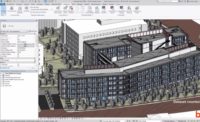In a surprise joint announcement, the two leading—and rival—vendors of design and analysis software say they have agreed to exchange their software libraries and support each other's application programming interface tools to improve interoperability between their products.
The day of the announcement, July 8, may go down as a historic great leap forward, creating a link between the two most widely used suites of architectural, engineering and construction tools.
The design tools of Autodesk, San Rafael, Calif., and Bentley Systems, Exton, P.A., are often used by project collaborators who have long complained of limited compatibility when exchanging designs between the platforms. Now the companies pledge to share with each other the information needed to improve each company's ability to read, write and submit in the file format of its competitor. There are many technical issues and questions to be resolved, but they say the cooperation has begun.
“By virtue of this agreement, and the interoperable offerings that it will enable, AEC firms will be free to employ software tools of choice from either Autodesk or Bentley to accept or submit either DWG or DGN files,” the companies’ joint statement declares. “By improving fidelity of work shared between the two file formats, users will be able to focus on being creative and getting work done, rather than being constrained by file compatibility considerations.”
“It just made all the sense in the world,” says Amar Hanspal, Autodesk’s senior vice president, platform solutions and emerging business, responding to questions about the timing of the decision during a press conference after the announcement. Jay Bhatt, senior vice president of Autodesk AEC Solutions, says that the rapid globalization of the industry and users’ need to work in distributed locations with many tools and bring data together in collaboration, particularly through building Information modeling, is the driver. “Teams are working differently than they were. BIM has become a true driver in the industry,” Bhatt says.
“This agreement should be regarded as a sudden huge leap forward,” says Greg Bentley, CEO of Bentley Systems. He says the companies and their customers will benefit; users by being able to work more efficiently, and vendors through increased demand for their products. “This is a significant investment on both of our parts, but the return is very significant as well,” Bentley says.
The interoperability problem has become a drag on the development and use of building information modeling, where 3-D design models are used as the common framework for organizing more and more associated project information.
Patrick MacLeamy, a founder and current chair of the International Alliance for Interoperability and CEO of the global architectural firm HOK, also welcoms the move and calls it “an important step toward enabling AEC Information to be more broadly shared, increasing the value of BIM to our clients.”




Post a comment to this article
Report Abusive Comment